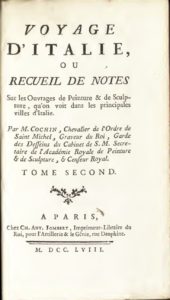
Charles-Nicolas Cochin was a French engraver, writer and art critic. He learned painting and engraving from his artist father. Among Cochin’s famous works are the illustrations for La Fontaine’s Fables. Voyage d’Italie is an abridgment of the notes and observations on the masterpieces seen in Italy, recorded by the artist during the trip he made between 1749 and 1751, in the company of the Marquis de Marigny (future director general of King’s Buildings), and the architect Soufflot and the Abbé Leblanc. In this book, Cochin writes about relatively small cities, like Colorno and Foligno, but not Rome. He explains in the preface: “I have not written anything about the masterpieces of art seen in Rome. This city contains such a large number of them, that I did not have enough time to collect notes on them.” Cochin’s guide remained a reference work for many years, particularly for travelers eager for artistic knowledge, and it is still a valuable source for art historians today. The description of the Camposanto includes his observations about the architecture and the wall paintings. Art being the principal interest of his travel, or perhaps because the legend of the holy earth is slowly dying out around the mid-eighteenth century, Cochin does not mention anything about the effect of the holy earth. / DJ
Cochin_Voyage d'italie (excerpt)Source: Charles-Nicolas Cochin, Voyage d’Italie, Ou Recueil De Notes Sur Les Ouvrages De Peinture & De Sculpture, Qu’on Voit Dans Les Principales Villes D’italie, 3 vols. (Paris: Jombert, 1758), 2:102-103.
Transcription
“Campo Santo, édifice gothique, assez beau. C’est un grand cloître, au milieu duquel est un cimetiere de terre apportée, dit-on, de Jérusalem. Il y a quantité de tombeaux de marbre, dont quelques-uns sont antiques: mais ils ne sont pas d’une beauté digne de remarque. Ce cloître est décoré de peintures anciennes, dès les commencemens de la peinture, par conséquent mauvaises: on y remarque cependant déjà une facon de draper & de former les plis, fort bonne, quoique séche et des caracteres de têtes, qui ont de la vérité, mais baisse: il semble que ce soit des portraits servilement & froidement rendus.
Le six Histoires de Job sont dites du Giotto; le Jugement dernier, d’André d’Orcagne et l’Historie de S. Ranieri, de Simon Memmi. Ce cloître est bâti de marbre, comme presque tous les édifices importans de cette ville, le voisinage des carrieres le rendant très-commun dans ce pays.”
Translation
Campo Santo, a gothic building, quite beautiful. It is a large cloister, in the middle of which is a cemetery of earth, which is said to be brought from Jerusalem. There are many marble tombs, some of which are ancient, but they are not of a beauty worthy of note. The cloister is decorated with ancient paintings, from the very beginning of painting, and therefore bad. One notices, however, a way of draping and forming pleats that is very good, although dry, and the heads of characters have authenticity, but are flawed: they seem to be slavishly and coldly rendered portraits.
The six stories of Job are said to be by Giotto; the Last Judgment, by Andrea Orcagna, and the story of Saint Ranieri, by Simon Memmi [=Simone Martini]. The cloister is built from marble, like almost all of the important buildings of this city, the proximity of the quarries making it very common in this country.
